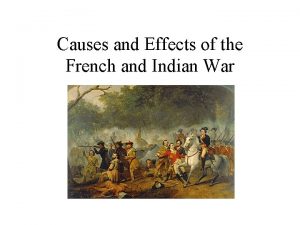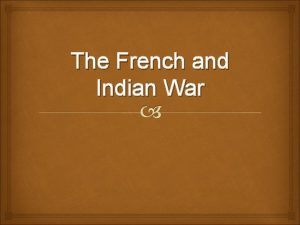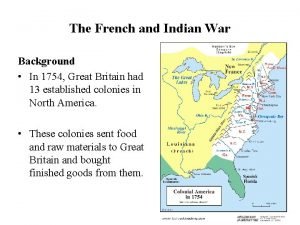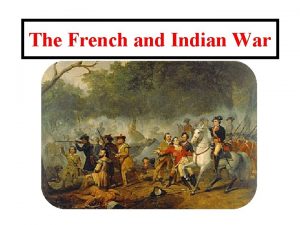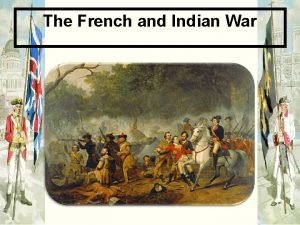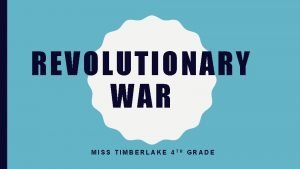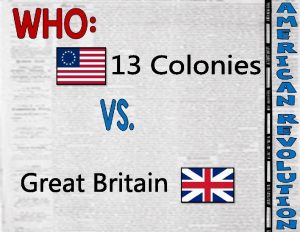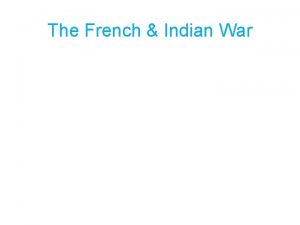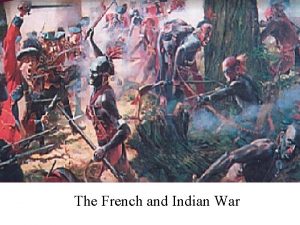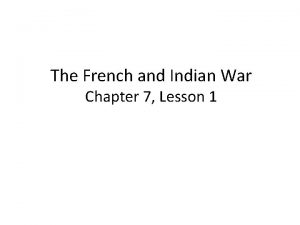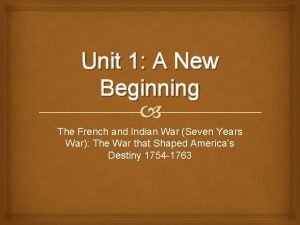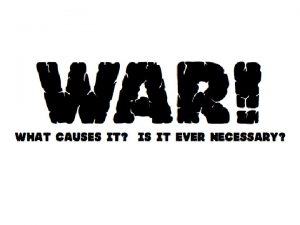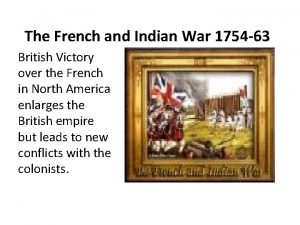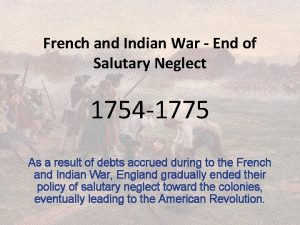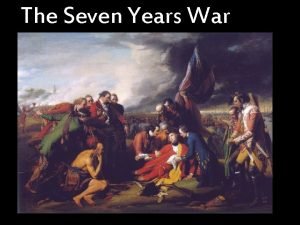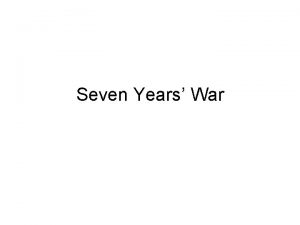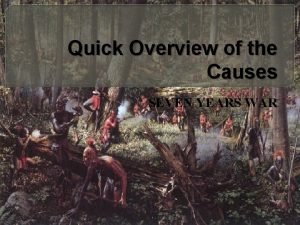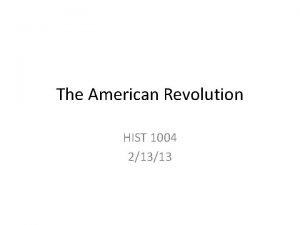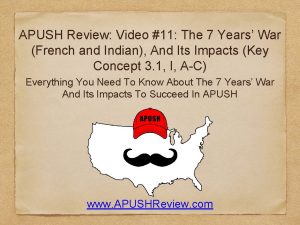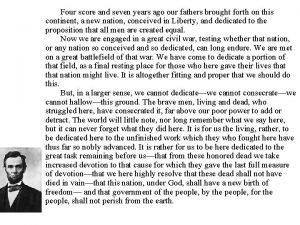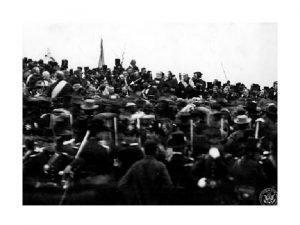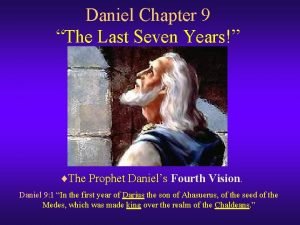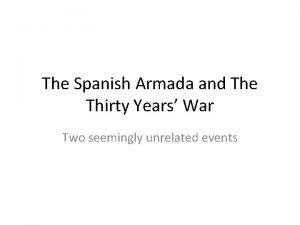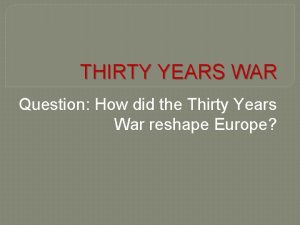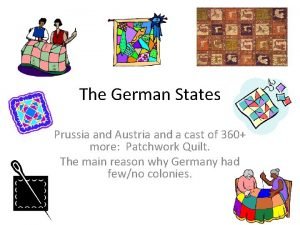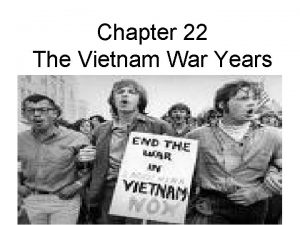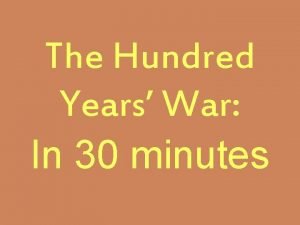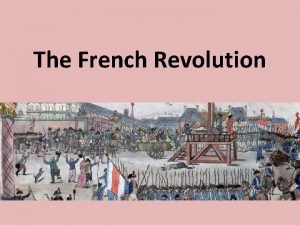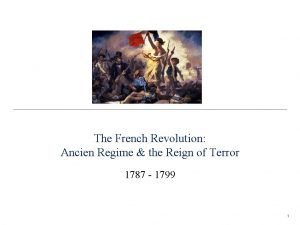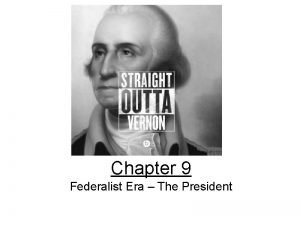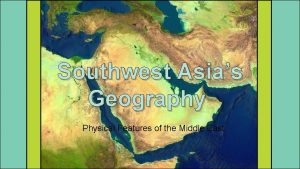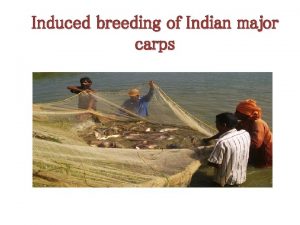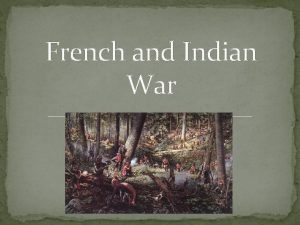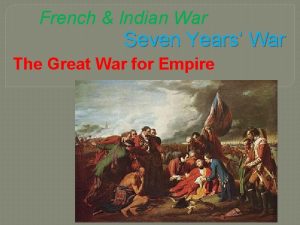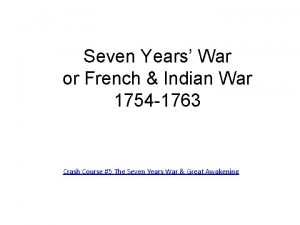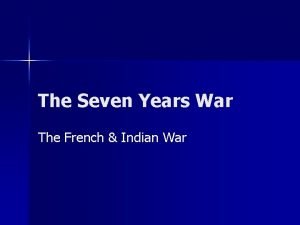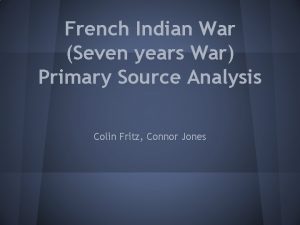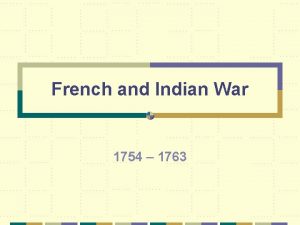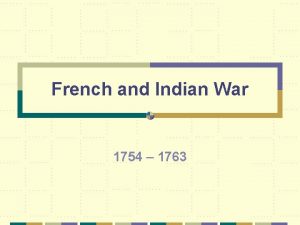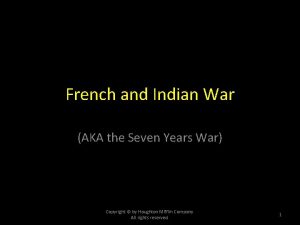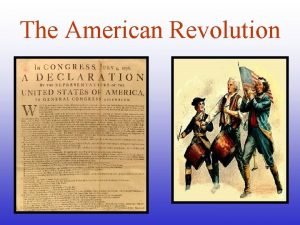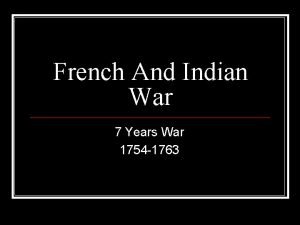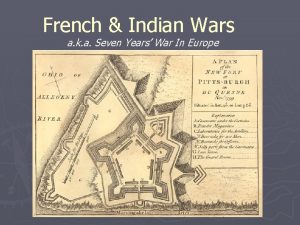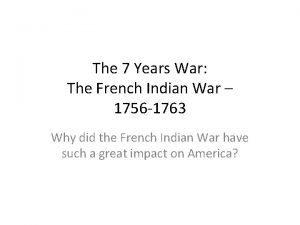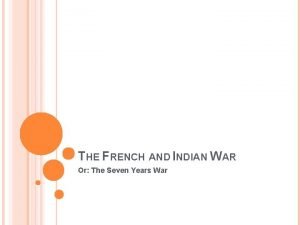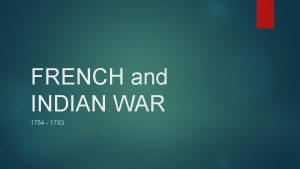French and Indian War Europes Seven Years War

























































- Slides: 57

French and Indian War Europe’s Seven Years War! Truly the First WORLD WAR CICERO © 2011

Interactive Menu • Causes of the War • Background • Events Leading to War • Leaders and Battles • Immediate Outcome • Why It Matters Now CICERO © 2011

CAUSES OF THE WAR CICERO © 2011

Britain and France • The conflict known as the Seven Years’ War in Europe and the French and Indian War in America developed over a long period. • It had roots in a struggle between Britain and France that had been going on for nearly 200 years. • The struggle stemmed from each nation’s – position in European power politics – pursuit of mercantilism – global expansion • The Anglo-French rivalry often erupted into military conflicts. CICERO © 2011

Competing Goals British Goals: French Goals: • Dominate Europe politically and economically • Control as much territory as possible ct! i l f Con CICERO © 2011 • Maintain their own political and economic power • Control as much territory as possible

Colonists, Indians, and Fur • Colonial American fur traders from Pennsylvania and Virginia wanted to trade with native tribes in the Ohio River Valley. • However, French colonists had long claimed the Ohio Valley as part of New France. • The fur trade also magnified animosity between American Indian tribes who competed with one another for territorial dominance. CICERO © 2011

BACKGROUND CICERO © 2011

Confusing Name for a War • The struggle between Britain and France and their European allies can explain much of the Seven Years War, as it was called in Europe. • Nevertheless, a large part of the fighting actually took place in North America. • The war even started about 2 years earlier in North America than it did in Europe. – The fighting began in the Ohio River Valley in 1754 and it didn’t spread to Europe until 1756. – Using the earlier date, it could have been called the Nine Years War. • In America, however, the war was not known as the Seven Years War. CICERO © 2011

Confusing Name For a War • In America, the war became known as the French and Indian War. • The American name for the war reflected the local focus that colonists had on the events of the war. • For American colonists, it would be remembered as the war in which they fought the French and (most of) the Indians; not as the vast war for empire known in European history as the Seven Years War. CICERO © 2011

Choosing Sides • American Indians played a major role on both sides of this conflict. • They were not bystanders caught in the crossfire. • Instead, they were willing participants with motives of their own. • In order to fully understand those motives, it is important to examine the interactions between colonists and the indigenous tribes in America prior to the war. CICERO © 2011

Native Tribes & the English • A short period of friendship between English colonists and native tribes followed the initial settlements in Virginia and Massachusetts. • However, tension soon arose, usually due to conflict over land: – English colonial populations quickly grew; – They set up permanent settlements, cleared the land, built large farms and towns and cities; – This tended to come into conflict with tribal land use patterns. • The tribes soon realized that the English settlers’ plans involved eventually moving them out, one way or another. CICERO © 2011

Native Tribes & the French • The French, in contrast, were more interested in doing business with the Indians than pushing them out of the area. – They were especially interested in the extremely profitable fur trade. – The Indians supplied the furs in exchange for tools, weapons, and brandy. • From a business standpoint, it would not have made sense to anger the Indians by occupying their land. • Unlike farmers, fur traders did not need much land anyway. CICERO © 2011

Native Tribes & the French • Therefore, the French left a much smaller footprint on the land than their British counterparts: – There were about 60, 000 French settlers in North America in 1754. – By contrast, there were over a million British colonists in North America by 1750. • The French were also willing to assist their trading partners in armed conflicts against rival tribes. In 1609, Samuel de Champlain and 4 others joined Algonquin and Huron Indians in a campaign against the Iroquois. CICERO © 2011

The Iroquois • The exception to this pattern of cooperation with the French was the Iroquois Confederation. – The Confederation was a group of 6 tribes; – Collectively, they formed most powerful American Indian group in Eastern North America. • Smaller tribes saw the Iroquois as a threat long before the British and French arrived on the scene. • Sporadic fighting and warfare between the Iroquois and other tribes were common occurrences. CICERO © 2011

Francophobe Iroquois • The Iroquois saw the French as an enemy because – They had some clashes with early French explorers; – the French were always willing to defend their trading partners in the smaller tribes. • The Iroquois tribes also had commercial relations with the British and sided with the British Crown during the war. • They proved to be a powerful ally. In 1754, delegates from 7 colonies met with leaders of the Iroquois Confederacy to convince them to join the effort to curb France’s domination of the fur trade. CICERO © 2011

EVENTS LEADING TO WAR CICERO © 2011

Events Leading to War • In 1749, some prominent Virginia planters formed the Ohio Company. – They were interested in claiming the region as part of the Virginia colony*. – With the support of English financers, they received a royal grant of 200, 000 acres in the Ohio River Valley. • The French quickly moved troops in to protect the territory from British and American land speculators and fur traders. CICERO © 2011

Events Leading to War • In 1753, the French began building a series of forts along the Allegheny River. • The British government ordered colonial governors to resist the French advance, "by force" if necessary. • Virginia Governor Robert Dinwiddie sent a 21 – year – old George Washington to Fort Le Boeuf. • His mission: Warn the French to leave the area. CICERO © 2011

George Washington • George Washington has the well -earned reputation as the Father of the United States. – Without question he set the standard for all presidents who followed him. – Without his valor as general, there would most likely never have been an independent United States. • The future rebel general began his military career in the Virginia militia, where he earned a reputation for extreme bravery. Ironically, his reputation for courage came after the young Washington made some major military mistakes in 1754. CICERO © 2011

Washington’s First Command • Washington left Williamsburg in late 1753 with an 8 – man party to deliver the warning. • They travelled hundreds of miles through the wilderness to the proximity of modern Erie, Pennsylvania. • The French refused to leave and sent Washington back to Virginia. • Before Washington returned, a small Virginia force was sent to build Fort Prince George at the fork where the Allegheny, Monongahela, and Ohio Rivers meet*. CICERO © 2011

Fort Duquesne • Washington’s report caused quite a stir in Virginia and England. • Governor Dinwiddie sent Washington back to the area; this time his objectives were – to solidify Virginia’s claim to the Ohio territory; – help defend Fort Prince George. • Before Washington arrived, a French force had captured the incomplete fort and built Fort Duquesne in its place. CICERO © 2011

Jumonville Glen May 28, 1754 • After learning that the French now controlled the fort, Washington decided to set up camp at a clearing known as Great Meadows. • A small French force under command of Ensign Joseph Jumonville was sent from Fort Duquesne to intercept Washington’s party. • A Seneca chief and British ally named Tanaghrisson warned Washington of the approaching French troops. CICERO © 2011

Jumonville Glen May 28, 1754 • Tanaghrisson persuaded the young Washington to ambush the French, which he did on the morning of May 28, 1754. • The French called for a ceasefire, but according to some accounts, Tanaghrisson ended any chance for a peaceful solution by killing Jumonville brutally with a tomahawk*. • Realizing that more French troops would soon arrive, Washington ordered his men to return to Great Meadows where they constructed the aptly named Ft. Necessity. • Less than a month later, Washington and his men were indeed attacked by a much larger French force. CICERO © 2011

The North American Theater LEADERS AND BATTLES CICERO © 2011

Three Phases of the War Phase 1 Phase 2 Phase 3 1754 – 1756 – 1758 – 1763 • Local actions in North America beginning with Fort Necessity; • Most action is about trying to capture frontier forts; • The British are largely unsuccessful. • Begins with a real declaration of war (May 15, 1756); • • Touches off a true world war (Seven Years War); Britain decides to concentrate on North America; • Britain invests HUGE amounts of money; • Ends with British victory. • Both sides commit more men and resources. CICERO © 2011

Phase 1 Fort Necessity/Great Meadows July 3, 1754 • When word of Jumonville’s death reached Fort Duquesne, a party of 600 French, Canadian, and Indians set out to attack Washington’s force on June 28, 1754. • They reached Fort Necessity on July 3 rd. • Although he and his men fought valiantly, Washington was soon forced to surrender. • The surrender document, written in French, contained a confession to the murder of Ensign Jumonville*. CICERO © 2011

Phase 1 The British Plan of Attack • Authorities in England were not going to let the French attack on Fort Necessity go unanswered. Beausejour • In 1755, they launched a 4 pronged plan: – General Edward Braddock would lead an attack on Ft. Duquesne; St. Frederic – Lt. Col. Robert Monckton would lead an attack on Ft. Beausejour; – Sir William Johnson would lead an attack on Ft. St. Frederic; – Massachusetts Governor William Shirley would fortify Ft. Oswego, then lead an attack on Ft. Niagara. CICERO © 2011 Niagara Oswego Duquesne

Phase 1 General Braddock Arrives • General Braddock brought 2 regiments to America, which he planned to supplement with provincial recruits. • Braddock also needed a guide to lead the way, a position well suited to Lt. Col. George Washington. • On May 29, 1755, Braddock and Washington set out from Maryland to capture Fort Duquesne with a force of 1, 500 British troops and Virginia militia. CICERO © 2011

Monongahela Phase 1 July 9, 1755 • Braddock assumed the mere sight of British regulars would cause panic among the French and their indigenous allies. • Washington warned that they should expect guerilla warfare from the enemy. • Braddock, however, stubbornly refused to believe that the French would fight anything other than a European-style battle. • Braddock’s column crossed the Monongahela River on July 9, 1755. CICERO © 2011

Linear Warfare Guerilla Warfare • Europeans fought in line formation. • Soldiers who engage in Guerilla Warfare rely heavily on the element of surprise. • This tactic was used because the guns were so inaccurate that soldiers had to fire at the same time in order to inflict casualties. • After firing 4 – 5 shots, soldiers would affix their bayonets and fight hand to hand with the enemy line. • American colonists usually fought in the European style. • However, they learned Guerilla tactics from American Indians during the French and Indian War. • American Indians often used ambushes, or sneak attacks, to catch the enemy off guard. • The British regarded such tactics as dishonorable. CICERO © 2011

Monongahela Phase 1 July 9, 1755 • As Washington had predicted, lead elements of the column were attacked immediately. • British troops were trapped in a ravine; panic quickly ensued. • Casualties were extremely high and Braddock was killed while rallying his men. • Washington assumed command made a hasty retreat. Before he died, Braddock promised to make Washington an officer in the British Army. Washington, however, was blamed for the defeat and denied the commission. CICERO © 2011

Monongahela July 9, 1755 • Despite the failure of the mission, Washington was hailed as a hero: – Colonists knew that 60% of the officers and enlisted men were killed or wounded; – They also knew that it was Washington who led the survivors safely back to Virginia. • His fame spread quickly throughout the colonies: – As a result of his western exploits, Washington became the best known American in all 13 colonies, other than Ben Franklin. CICERO © 2011 Phase 1

Phase 1 Shirley & Johnson • Inexperienced and disorganized, Governor Shirley never made it to Fort Niagara. Beausejour • By late August, Johnson and his men were camped at Fort Edward, preparing for their attack on Fort St. Frederic Lake George • Johnson defeated a French force led by Baron Dieskau near Lake George, but never took Fort Saint Frederick. Ft. Edward Monkton’s attack against Beausejour would become the only true strategic victory of 1755*. CICERO © 2011

Phase 2 A Declaration of War • On May 15, 1756, England officially declared war on France and its allies. • Now, fighting would take place in Europe, India, and on the high seas, as well as in North America. • General John Campbell was given command of British forces in North America. • Despite more funding and troops, the British continued to loose battles in the North American theater. Unpopular and unsuccessful, John Campbell (left) was replaced by General James Abercrombie (right) in 1758. CICERO © 2011

Phase 2 Louis-Joseph de Montcalm • General Montcalm arrived in Montreal in May of 1756 to take command of French forces in North America. • Montcalm first reinforced defenses at the newly built Fort Carillon on Lake Champlain. • He then launched a successful attack against Fort Oswego in August of 1756. CICERO © 2011

Fort William Henry Phase 2 August 1757 • The British surrendered after enduring five days of heavy bombardment from an army of French soldiers and Indian warriors. • The French allowed the British to leave peacefully. • However, their Indian allies brutally attacked the fleeing British soldiers and civilians. • They took several hostages and killed roughly forty others. Some French officers did attempt to stop the slaughter, but others did nothing to protect the British. CICERO © 2011

Fort William Henry August 1757 • The Battle of Fort William Henry is perhaps one of the most famous battles of the war. • James Fenimore Cooper’s novel, The Last of the Mohicans, immortalized the aftermath of the siege. • Ironically, the battle had no real strategic significance. CICERO © 2011 Phase 2

Phase 3 William Pitt • By 1758, British Secretary of State William Pitt was given almost complete control over the war effort. • Pitt viewed North America as the most important theater of the war. • In order to devote more British troops and ships to North America, Pitt paid the Prussian monarch for supplies and soldiers to fight the war in Europe. • To gain support in the colonies, Pitt reimbursed colonial governments that provided militia and supplies. CICERO © 2011

Phase 3 The St. Lawrence River • The French and Indian War may have started as a dispute over conflicting land claims in the Ohio River valley. • However, William Pitt had redefined it as a struggle between Britain and France for control of eastern North America. • The French controlled Eastern Canada, which consisted of a string of settlements along the St. Lawrence River from the Atlantic to the Great Lakes. • With their capital at Montreal, the most strategic location was the heights occupied by the city of Quebec, which overlooked a crucial bend in the river. • However, the mouth of the Saint Lawrence was well guarded from a French fortress located at Louisbourg on the Ile Royale. CICERO © 2011

Siege of Louisbourg June 8 – July 26, 1758 • Beginning in early June, General Jeffrey Amherst led an attack against the French fortress at Louisbourg. • Amherst was supported by a British naval fleet led by Admiral Edward Boscawen. • An initial landing force led by Brigadier General James Wolfe was able to secure an inlet beach west of the fortress. CICERO © 2011 Phase 3

Siege of Louisbourg Phase 3 July 26, 1758 • A few days later, Wolfe secured Lighthouse Point located on the opposite side of the harbor. • With the French surrounded, the British began a barrage of canon and mortar fire that lasted more than a month. • On July 25, the last two French ships defending the harbor were captured; French Commander Drucour had little choice but to surrender, which he did on July 26. • The loss of Louisbourg had opened the Saint Lawrence River to the British Navy. CICERO © 2011

Phase 3 Quebec City • Whoever controlled Quebec could monitor, prevent or permit any traffic that came up or down the river. • With Quebec in British hands: – the French fur trade in the west would be under their control; – the capital of Montreal would be cut off from contact with France. • The city, however, was wellfortified by its natural geography and its man-made defenses. The British chose General James Wolfe, hero of Louisbourg, to lead the attack against Quebec. CICERO © 2011

Phase 3 An Impenetrable City • Quebec CIty is located on high ground that rises quickly going in from the banks of the river. • At the top of the hill was The Citadel, a fortress of stone walls with its own internal water supply and ample artillery. • The only reasonably level land adjoining The Citadel was the Plains of Abraham. • However, to reach that area from the river, it was necessary to scale high cliffs. • The climb could be done out of the reach of the French cannons. CICERO © 2011

Phase 3 It’s Now or Never • Wolfe could not afford to wait too long to attempt a siege of the city and try to get General Montcalm to surrender. • If the fall came without a surrender, the British would have had to end their siege because ice soon would have choked the St. Lawrence River and ended their ability to get supplies. • So, on the night of September 12, 1759, British troops scaled the cliffs rising from the River. • By daybreak, they were gathered on the Plains of Abraham. CICERO © 2011

The Battle of Quebec Phase 3 September 13, 1759 • General Wolfe challenged General Montcalm to bring his army out of Quebec City and engage the British in open battle. • Remarkably, Montcalm accepted the challenge*. • The British defeated the French. • Both Wolfe and Montcalm were killed in this battle Montcalm leading his troops at the Plains of Abraham by Charles William Jeffreys CICERO © 2011

Phase 3 A Double Loss • The British victory on the Plains of Abraham ended French dominance in North America, even though Montreal would not fall for another year. • The war took a few more years to actually end because the European theater had to play out. • Nevertheless, the Battle of Quebec had decided the fate of the North American continent for centuries to follow. CICERO © 2011

THE IMMEDIATE OUTCOME CICERO © 2011

The Treaty of Paris, 1763 • The French agreed to give all of its North American holdings east of the Mississippi River to Britain; French territory west of the Mississippi, as well as Cuba, went to Spain. • Spain ceded Florida to Britain, while Britain returned Caribbean sugar islands, as well as trading ports in India, to France. • Britain also promised to allow free practice of the Catholic faith in Canada. • The great European powers agreed to end hostilities and return to status quo antebellum, which means everything went back to the way it was before the war. CICERO © 2011

Before After CICERO © 2011

The Proclamation of 1763 • After natives who had allied with the French found out they would lose their territory, they began attacking the British and their American colonists. • Many tribes feared that the Iroquois would begin to move into the Ohio Valley and expand their territory. • The Indian uprising was known . as Pontiac’s Rebellion and would lead the British, to announce the Proclamation of 1763. CICERO © 2011

The Proclamation of 1763 • The Proclamation of 1763 forbid colonists from settling west of the Appalachian Mountains. • This particularly infuriated the Ulster-Irish frontiersmen who had allied with the British so they could move into the fertile Ohio Valley. • These settlers later became a major component* of the Continental Army during the American Revolution. CICERO © 2011

Consequences • Wars are costly, but this war was particularly expensive; it nearly bankrupted the British treasury. • While the war was fought in Europe and India as well as in North America, many in the British leadership believed, with some justification, that the war had been started by the colonists and was fought to protect them. • In comparison with Britain, the colonies had grown wealthy. • The time had come, the mother country reasoned, for her children in the colonies to pay their fair share, at least in the area of their own protection. • In addition, the rulers of Britain wanted to be sure the colonists did not trigger another costly war. CICERO © 2011

Consequences • With these notions in mind, Britain passed several acts designed to maintain the peace and replenish the British treasury. • The colonists, accustomed to decades of salutary neglect, viewed these acts as intrusive and tyrannical. • They felt they were being unduly punished even though they had contributed much to the recent victory. • Acts such as the Stamp Act, among others, while defensible in Britain were reprehensible to the colonists who greeted each successive act with increased resistance and eventually armed revolt. CICERO © 2011

WHY IT MATTERS NOW CICERO © 2011

Why It Matters Now • American history and culture might have been quite different had this conflict not occurred and played out as it did: – It set the tone for relations between the European-Americans and American Indians for generations to come. – It determined that the portion of North America that would become the United States and Canada would be dominated by English culture and common law*. – The enormous costs of this war sparked the unrest that led directly to the American Revolution. – Finally, participation in the war gave American colonists the military experience and confidence they would need to win their independence from Britain. CICERO © 2011

An Anglo Saxon World • On a global scale, the war established a balance of power in the Western world that would remain largely unchanged until the start of the “so-called” First World War in 1914*. • It not only determined which nations would dominate Europe during the later 19 th century; it determined which Empire would dominate the world for the following 150 years. • It also set the stage for the Anglo-American cultural and economic domination of the following two centuries. CICERO © 2011

Bibliography • Fred Anderson. Crucible of War: The Seven Years' War and the Fate of Empire in British North America, 1754 -1766 (January 23, 2001). • D. A. Baugh The Global Seven Years War 1754 -1763: Britain and France in a Great Power Contest (July 23, 2011). • George Alfred Henty. With Frederick the Great - A Story of the Seven Years' War (Jul y 12, 2010). • James G. Leynurn. The Scotch Irish: A Social History. (August 30, 1989). • Franz A. J. Szabo. The Seven Years War in Europe: 1756 -1763 (September 2, 2007). • Richard W. Van Alstyne. Empire and Independence: The International History of the American Revolution (April 1967). • Russell Weigley. The American Way of War: A History of United States Military Strategy and Policy (June 1, 1977). CICERO © 2011 END
 How many years is four score and seven years
How many years is four score and seven years Causes and effects of the french and indian war
Causes and effects of the french and indian war Where did the french and indian war take place
Where did the french and indian war take place Causes of french and indian war
Causes of french and indian war Causes of french and indian war
Causes of french and indian war French and indian war summary
French and indian war summary French and indian war
French and indian war Brainpop french and indian war
Brainpop french and indian war Who was in debt after the french and indian war
Who was in debt after the french and indian war French and indian war
French and indian war French and indian war
French and indian war French and indian war
French and indian war French and indian war
French and indian war New beginning in french
New beginning in french French and indian war
French and indian war French and indian war
French and indian war The french and indian war was fought between
The french and indian war was fought between French and indian war
French and indian war Define salutary neglect
Define salutary neglect What caused the seven years war
What caused the seven years war What caused the seven years war
What caused the seven years war Causes of the seven years war
Causes of the seven years war Seven years war
Seven years war Seven years war apush
Seven years war apush Four score and seven years ago
Four score and seven years ago How long is four score and 7 years
How long is four score and 7 years Sheep years to human years
Sheep years to human years 300 solar years to lunar years
300 solar years to lunar years 7 deadly sins vs 7 heavenly virtues
7 deadly sins vs 7 heavenly virtues Last seven years
Last seven years Hapsburgs
Hapsburgs Thirty years' war causes
Thirty years' war causes Prussia
Prussia 30 years war phases
30 years war phases The vietnam war years chapter 22
The vietnam war years chapter 22 Héroïne dans la guerre de 100 ans (100 years war).
Héroïne dans la guerre de 100 ans (100 years war). Consequences of the 100 years war
Consequences of the 100 years war Flossies kitten rescue
Flossies kitten rescue France monarchy timeline
France monarchy timeline The ancien regime
The ancien regime The federalist era lesson 3
The federalist era lesson 3 Toward civil war lesson 3 secession and war
Toward civil war lesson 3 secession and war India is known for its unique vocals
India is known for its unique vocals The treble of heaven's harmony meaning
The treble of heaven's harmony meaning War at home and abroad madison
War at home and abroad madison Description
Description The cold war begins lesson 1
The cold war begins lesson 1 Reconstruction venn diagram
Reconstruction venn diagram Why did josette dugas want to go to war
Why did josette dugas want to go to war Ich war, du warst
Ich war, du warst Force and motion study jams
Force and motion study jams Why was the civil war considered the first modern war
Why was the civil war considered the first modern war Bringen simple past
Bringen simple past Proxy war cold war definition
Proxy war cold war definition Chapter 30 the war to end war
Chapter 30 the war to end war Chapter 30 the war to end war
Chapter 30 the war to end war Inlet of indian ocean between africa and asia
Inlet of indian ocean between africa and asia Induced breeding of indian major carps
Induced breeding of indian major carps

